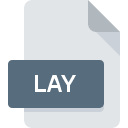.LAY File Extension

Tecplot Layout File
| Developer | Tecplot |
| Popularity | |
| Category | Data Files |
| Format | .LAY |
| Cross Platform | Update Soon |
What is an LAY file?
.LAY files, also known as Tecplot Layout Files, are utilized to store layout configurations in Tecplot software. Tecplot is widely employed in engineering and scientific fields for visualizing and analyzing complex simulation data obtained from computational fluid dynamics (CFD), finite element analysis (FEA), and other numerical simulations.
The layout files play a crucial role in preserving the arrangement of plots, annotations, axes, and other visual elements within Tecplot’s workspace. They essentially serve as templates for recreating specific visualization setups, enabling users to efficiently reproduce and share their analyses.
More Information.
The history of .LAY files are intertwined with the evolution of Tecplot itself. As Tecplot gained prominence in the scientific and engineering communities, the need for a standardized method to save and share visualization setups became apparent. Consequently, .LAY files were introduced to fulfill this requirement.
.LAY files served the fundamental purpose of storing layout configurations, including plot arrangements, styling preferences, annotations, and viewport settings.
They provided users with a convenient means to preserve and reproduce their visualization setups, thereby enhancing productivity and facilitating collaboration among researchers and engineers.
Origin Of This File.
Tecplot, developed by Amtec Engineering, Inc., first emerged in the early 1980s as a solution for engineers and scientists to visualize and analyze complex data resulting from simulations.
Over the years, Tecplot has evolved into a comprehensive software suite, offering advanced capabilities for data visualization, analysis, and exploration.
The introduction of .LAY files came as a means to streamline the process of saving and recalling visualization layouts within Tecplot’s environment.
Before their implementation, users had to manually recreate desired configurations for each analysis session, leading to inefficiencies and potential errors.
File Structure Technical Specification.
.LAY files adhere to a specific structure designed to encapsulate the various elements comprising a Tecplot layout.
While the exact specifications may vary based on the version of Tecplot being used, the core components typically include:
- Plot Configurations: Information regarding the type of plots (e.g., 2D, 3D, XY) and associated settings (e.g., variables, colormap, contour levels).
- Annotation Details: Annotations such as text labels, arrows, and shapes, along with their respective positions, orientations, and formatting attributes.
- Viewport Settings: Parameters defining the viewport dimensions, orientation, and camera perspective for 3D plots.
- Styling Preferences: User-defined preferences for visual elements such as line styles, marker types, font styles, and color schemes.
The precise organization and formatting of data within .LAY files are governed by Tecplot’s internal specifications, ensuring compatibility and consistency across different versions of the software.
How to Convert the File?
Converting .LAY files to other formats or vice versa can be challenging due to the proprietary nature of Tecplot’s file formats. Some approaches may facilitate interoperability and data exchange:
- Export to Common Formats: Tecplot allows users to export visualization layouts to commonly used formats such as PNG, JPEG, PDF, and SVG, enabling easy sharing and integration with other software.
- Custom Scripts or Plugins: Advanced users may develop custom scripts or plugins to convert .LAY files to alternative formats or extract relevant data for further processing.
- Third-party Tools: Some third-party tools or utilities may offer limited support for converting .LAY files to more generic formats, although compatibility and fidelity may vary.
Advantages And Disadvantages.
Advantages:
- Efficient Workflow: .LAY files streamline the process of saving and recalling visualization setups, enhancing workflow efficiency.
- Standardization: By providing a standardized format for layout configurations, .LAY files facilitate seamless collaboration and knowledge sharing among users.
- Preservation of Analysis: Users can preserve their analysis setups, enabling them to revisit and refine their visualizations as needed.
Disadvantages:
- Software Dependency: .LAY files are tied to Tecplot software, limiting their utility outside of the Tecplot ecosystem.
- Compatibility Issues: Differences in Tecplot versions may lead to compatibility issues when opening .LAY files are created with older or newer versions.
- Limited Interoperability: The proprietary nature of .LAY files restrict interoperability with other visualization tools and software platforms.
How to Open LAY?
Open In Windows
- Double-click the .LAY file or launch Tecplot and use the “Open” command to load the file.
Open In Linux
- Launch Tecplot from the installed directory or through the terminal, then use the appropriate commands or menus to open the .LAY file.
Open In MAC
- Open Tecplot software from the Applications folder and navigate to “File” > “Open” to load the .LAY file.













